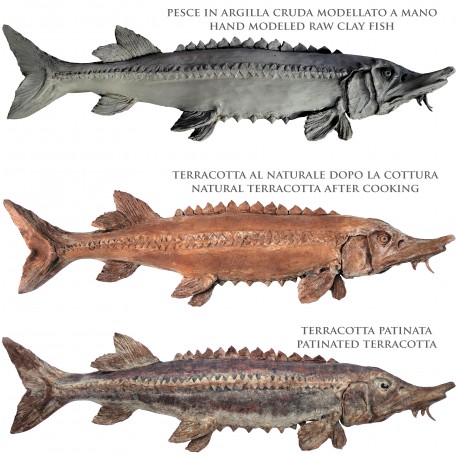Sturgeon in patinated terracotta
Handmade in terracotta without the aid of a "shape", this is a real sculpture in baked clay.
Represents 1: 1 the average size of this fish.
On request it can be reproduced of any size.
It can be reordered, however please bear in mind that each piece will be different from the previous one, ask for a photo before shipping.
The sturgeon (Acipenser sturio Linnaeus, 1758), also known as the common sturgeon, is one of the largest freshwater and brackish water fish widespread in Europe. It is famous for offering fine meats and caviar.
In Italy the species is native. It was reported in all seas even if the presence was significant only in the Adriatic Sea, as well as in the Po. In 1892 it was localized as far as Turin. Due to the barriers, the ascent is effectively prevented.
The Tiber was also rich in sturgeons, particularly in the stretch from Rome to the mouth from which they took the name of Tiber wolves and for their widely celebrated delicacy, their fishing was carried out between May and June by specialized operators and constituted an important source of income for the local market in Rome; it is said that in the mid-15th century seven were donated to Pius II, one of which weighed about 250 pounds, equal to over 110 kg.
According to various sources, the species is now extinct in Italy in the wild state; in Europe there is now only one breeding population in the Garonne river. Reports of sturgeon caught in Italian waters may refer to a similar species (Acipenser naccarii) or to specimens introduced by man.
The habitats are varied:
In the sea, it prefers sandy bottoms 40-150 m deep.
In inland waters it frequents large-flow rivers with slow and deep currents, muddy, gravelly or sandy bottoms. It prefers the deepest holes of rivers.
- Width
- 19
- Length
- 80
- Thickness
- 13
- Weight
- 4,5
- Manufacturing
- Made in Italy
- Material
- Terracotta
- Note 01
- Acipenser sturio Linnaeus, 1758















